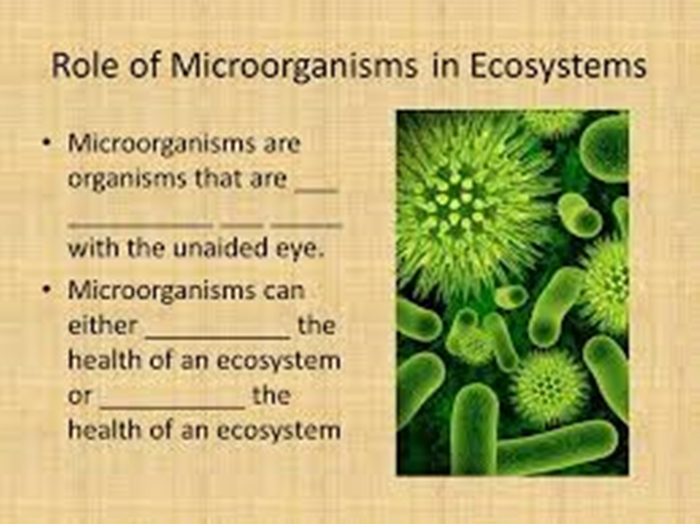In this article, we discussed the role of microorganisms in our ecosystem. We also talked about the meaning of microorganisms and ecosystem.
Definition
Microorganism is an organism that can be seen only through a microscope. Microorganisms include bacteria, protozoa, algae, and fungi. Although viruses are not considered living organisms, they are sometimes classified as microorganisms.
This can also be seen as a living thing that on its own is too small to be seen without a microscope.
Ecosystem is that it is a community or group of living organisms that live in and interact with each other in a specific environment.
The living parts of an ecosystem include animals (consumers), plants (producers), and fungi and micro-organisms (decomposers). The nonliving, or abiotic components of an ecosystem include the sun’s energy, water, air (atmospheric gases), and rock, which makes up the landforms.
The Role of Microorganism in our Ecosystem
Generate Oxygen in atmosphere:
Almost all of the oxygen produced in earth today occurs by bacteria in ancient period.
Most of the oxygen producers are blue-green algae in ocean.
Almost all of the production of oxygen by bacteria on Earth today occurs in the oceans by the cyanobacteria or “blue-green algae. And over time, most of the oxygen produced in Earth’s history has been done by bacteria.
Recycle nutrition stored in organic matters to inorganic form:
Microbial breakdown of organic matters releases the minerals such as N, P, K etc. and these minerals are bound up and made available for producers (green plants) to use. Without this recycling primary productivity of ecosystem would stop.
In soil, fungi are the most important decomposers of plant materials and are followed by bacteria. In water, the decomposition of organic matter is mostly toxic in streams and in the ocean and anoxic in the bottoms of lakes or in everglades. As shown in the table above, toxic decomposition proceeds faster (produces higher energy yields for the bacteria) than decomposition in environments where there is no oxygen. In the open ocean, the water is so deep (average 3900 m) and contains so much oxygen, that most of the algal-formed organic matter at the surface decomposes aerobically before it reaches the bottom. For example, only 2% of the primary productivity in the upper ocean sinks to a depth of 3500 m. Most of the world is ocean, and most of the ocean is deep, so most of the aquatic decomposition must be aerobic. But in shallow waters, coastal oceans, lakes and estuaries, 25-60% of the organic matter produced may settle out of the upper waters rapidly and be decomposed anaerobically (without oxygen).
Fix atmospheric Nitrogen into useable form:
The only organism capable of fixing atmospheric nitrogen into useable form are bacteria. These nitrogen fixing bacteria are Rhizobium, Cyanobacteria etc.
Another difficulty for the bacteria is that one of the enzymes necessary for nitrogen fixation is destroyed by oxygen (which is necessary for efficient ATP formation). One solution to this problem is to form symbiotic relationships with other organisms that can provide carbohydrates; these include diatoms, the fungi of certain lichens, shipworms, termites, and certain plants especially in nodules of the roots. These symbiotic relationships are often inside nodules surrounded by thick tissues, which limit the diffusion of oxygen and keep the bacterial enzymes from being inactivated by oxygen.
Microorganisms give plant roots excess to nutrition in soil:
Plant root creates a zone of nutrition reduction around their surface by using available nutrition.
A group of fungi called mycorrhiza found associated with rood hairs of plants helps in effective captivation of nutrition in soil.
The added advantage to the plant of forming these relationships with fungi is that the hyphae can secrete enzymes that break down organic molecules and make inorganic nutrients available. While the plants gain nutrients, the fungi gain carbohydrate food from the plant. There is also a cost to the plant in this association; one study reported that mycorrhizal biomass was only 1% of a fir forest ecosystem but used 15% of the net primary production.
Allows herbivore animals to get nutrition from poor quality food:
In ruminants’ animals the ingested food especially fiber, lignin etc. cannot be digested by digestive enzymes in gut but the rumen (stomach) of these animals contains numerous bacteria, fungi and protozoa that carry out fermentation where these complex carbohydrates are digested.
(cattle, deer, giraffe) the ingested food, possibly vomited and re-chewed, passes into the rumen together with saliva (60-100 liters produced per day). The rumen is really a constant fermenter where the complex carbohydrates of the plant are fermented by bacteria into methane, carbon dioxide, and fatty acids. The biota of the rumen is found in about equal biomasses of bacteria protozoans and fungi (poorly known biomass). About 60-65% of the total energy removed from the plant food that is ingested by the animal comes from rumen fermentation. Plant tissues passing from the rumen undergo secondary fermentation in the caecum and large intestine where an additional 8-30% of the total energy is provided.
Conclusion
Microorganisms play a vital role in every ecological community by serving both as producers and as decomposers. Although plants are the most common primary producers, autophytic photosynthetic microbes (such as cyanobacteria and algae) can harness light energy to generate organic matter. Additionally, in zones where light cannot enter (and thus photosynthesis cannot be the basic means to produce energy. chemosynthetic microbes provide energy and carbon to the other organisms in the ecosystem.


